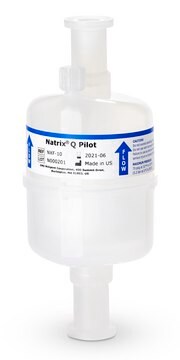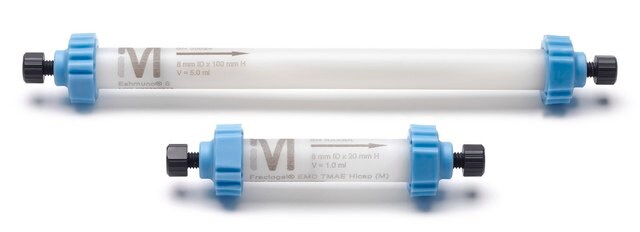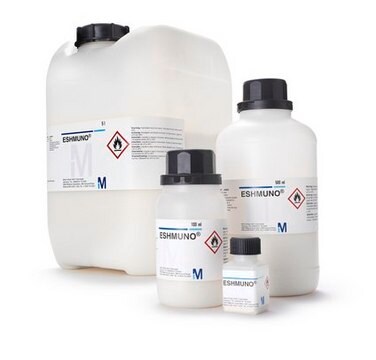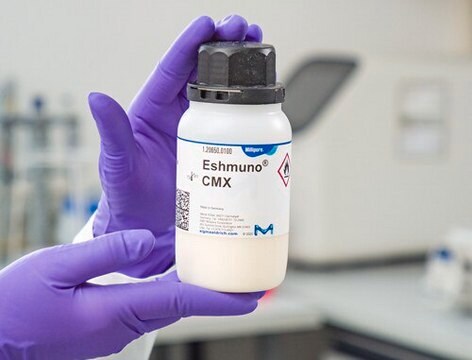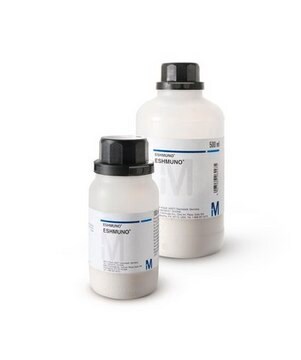1.20079
Eshmuno® Q Resin
Eshmuno® Q
Synonym(s):
Eshmuno® Q
About This Item
Recommended Products
Quality Level
ligand
(Trimethylammoniumethyl)
sterility
sterile (Caustic Stable)
product line
Eshmuno®
form
resin
specific analyte(s)
MAbs
parameter
1000 cm/hr flow rate
1000 cm/hr max. flow rate
8 bar max. pressure
matrix active group
polymer, polyvinyl ether
mean particle size
85 μm
capacity
150 mg binding capacity (BSA/mg of resin)
~150 mg, BSA binding capacity
transition temp
flash point 35 °C (own results)
density
1 g/cm3 at 20 °C
application(s)
recombinant protein
vaccine development
separation technique
anion exchange
mixed mode
storage temp.
2-30°C
Looking for similar products? Visit Product Comparison Guide
General description
Features and Benefits
- Purification of acidic and neutral proteins and peptides from different sources, including plasma
Superior productivity for downstream processing of biomolecules
- High flow rate versus pressure-flow behavior
- Excellent removal of impurities, such as HCP, leached Protein A, and viruses
- Robust and safe packing procedures
- Strong chemical stability
Packaging
- 1.20079.0100: Eshmuno® Q Resin 100ml
- 1.20079.0010: Eshmuno® Q Resin 10ml
- 1.20079.0500: Eshmuno® Q Resin 500ml
- 1.20079.5000: Eshmuno® Q Resin 5L
Analysis Note
Microscopic evaluation: Spherical particles, no agglomerates, no fines.
Extractable matter (water): ≤ 0.08 %
Ionic capacity: 90 - 190 µeq/ml
Performance test (conalbumin): 9 - 19 mS/cm
Performance test (human serum albumin): 20 - 30 mS/cm
Pressure drop(column: ID=1.6 cm, L=10 cm at 5 ml/min): ≤ 1.0 bar
Protein binding capacity(bovine serum albumin): 120 - 190 mg/ml
Particle size (50-120 µm): ≥ 80 %
Particle size (d50): 75 - 95 µm
Cerium: ≤ 30 µg/g
Endotoxins: ≤ 1.00 EU/ml
TAMC (total aerobic microbial count): ≤ 100 CFU/ml
TYMC (total yeast and mould count): ≤ 100 CFU/ml
Legal Information
signalword
Warning
hcodes
Hazard Classifications
Flam. Liq. 3
Storage Class
3 - Flammable liquids
wgk_germany
WGK 1
flash_point_f
95.0 °F
flash_point_c
35 °C
Certificates of Analysis (COA)
Search for Certificates of Analysis (COA) by entering the products Lot/Batch Number. Lot and Batch Numbers can be found on a product’s label following the words ‘Lot’ or ‘Batch’.
Already Own This Product?
Find documentation for the products that you have recently purchased in the Document Library.
Articles
See case study examples of how to optimize chromatographic purification of plasmid DNA for Biopharmaceutical Applications.
Influenza vaccines are commonly made using egg-based and cell-based manufacturing strategies. Find step-by-step information on the manufacturing process for each method.
A custom-designed cost model is used to explore the economics of vaccine manufacturing across several different modalities including mRNA. The model enables greater process understanding, simulates bottlenecks, and helps to optimize production efficiency.
Learn more one the attenuated viral vaccines manufacturing process: cell culture, clarification, nuclease treatment, chromatography, and sterile filtration.
Related Content
This technical article breaks down the adenovirus vaccine manufacturing process and provides a case study on developing an accelerated and cost-effective single-use adenoviral vector vaccine.
Learn more on mAb downstream processing, more specifically polishing chromatography and the relevant associated products.
Our team of scientists has experience in all areas of research including Life Science, Material Science, Chemical Synthesis, Chromatography, Analytical and many others.
Contact Technical Service
